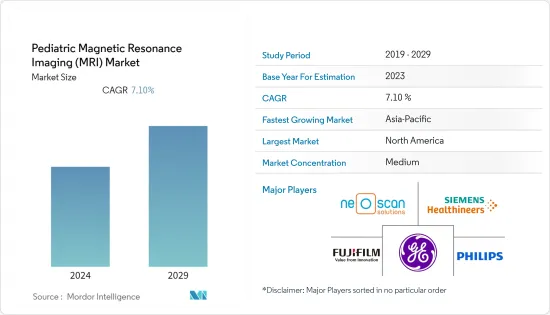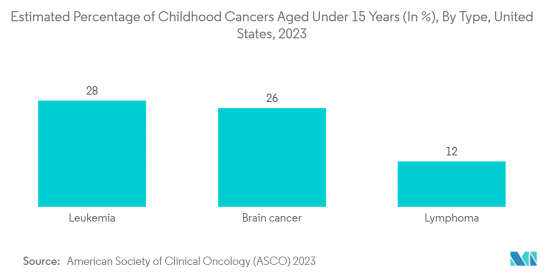
|
市場調査レポート
商品コード
1407038
小児用磁気共鳴画像診断(MRI):市場シェア分析、産業動向と統計、2024~2029年の成長予測Pediatric Magnetic Resonance Imaging (MRI) - Market Share Analysis, Industry Trends & Statistics, Growth Forecasts 2024 - 2029 |
||||||
カスタマイズ可能
適宜更新あり
|
|||||||
| 小児用磁気共鳴画像診断(MRI):市場シェア分析、産業動向と統計、2024~2029年の成長予測 |
|
出版日: 2024年01月04日
発行: Mordor Intelligence
ページ情報: 英文 120 Pages
納期: 2~3営業日
|
- 全表示
- 概要
- 目次
小児用磁気共鳴画像診断(MRI)市場は、予測期間中にCAGR 7.1%を記録する見込みです。

小児患者のケア、特にCOVID-19パンデミックの環境における特有の課題は、パンデミックの間、市場に悪影響を与えました。Pediatric Body MRIが2021年4月に発表したレポートによると、COVID-19のために数多くのMRIサービスが通常とは異なる課題に直面しました。米国におけるCOVID-19の第一波の間、多数のMRIサービスが大量の外来検査のキャンセルと再スケジュールの問題に対処し、市場に悪影響を与えました。しかし、同じ情報源によると、政府はCOVID-19感染を回避するために様々な公衆衛生対策を講じたため、ヘルスケア施設での放射線検査量が増加し、市場成長に大きな影響を与えたといいます。
市場の成長は、早産や小児疾患の負担の増加、小児画像診断技術の技術的進歩の拡大、世界の小児医療を強化するための共同研究、承認、発売の増加に起因すると考えられます。例えば、2022年11月にユニセフは、レバノンでは2021年に639人の新生児が生後28日を迎える前に死亡したと発表しました。このような早産による死亡の高い負担は、適切なモニタリングとMRI診断を用いることで軽減することが可能であり、市場の牽引役となることが期待されます。
さらに、政府のイニシアチブは、さまざまなキャンペーンによってこれらの死亡を管理するのに役立ちます。例えば、2022年11月、レバノン公衆衛生省はユニセフと共同で、新生児と未熟児に対する適切なヘルスケアの重要性に対する認識を高めるため、全国新生児・未熟児キャンペーンを開始しました。また、家族やヘルスケア提供者の重要な役割についても強調しました。したがって、新生児や小児科に関するこうしたキャンペーンは、MRIのような装置の需要を高め、予測期間中の市場の成長を押し上げると予想されます。
しかし、ヘリウムの入手可能性の低下と設置コストの高さが市場の成長を抑制しています。
小児用MRI市場の動向
予測期間中、がん領域セグメントが市場で大きなシェアを占める見込み
腫瘍学アプリケーション分野が大きな市場シェアを占めると予想されます。磁気共鳴画像(MRI)システムは、小児患者のがんを診断します。小児患者のがん負担の増加や市場参入企業による戦略的な取り組みがMRI画像診断の需要を高めており、市場成長に寄与しています。
例えば、米国がん協会は2023年1月に、米国では2023年に15歳未満の小児約9910人ががんと診断されると発表しており、相当数の患者がMRIを用いた診断の需要を高めています。また、同出典によると、米国では過去数十年間に小児がんの発生率がわずかに上昇しています。このようながん患者の増加はMRI装置の利用を増加させ、予測期間中に市場を押し上げると予想されます。
さらに、イニシアチブの増加が市場成長に寄与しています。例えば、2021年5月、ネオスキャン・ソリューションズは赤ちゃん用のMRIスキャナーを発明しました。この小型軽量MRIスキャナーは、病院の小児病棟に直接設置することができます。このような製品の発売は、MRIサービスの広範な流通を増加させ、市場の成長を促進すると予想されます。

予測期間中、北米が市場で大きなシェアを占める見込み
北米では米国が大きな市場シェアを占めると予想されます。市場成長を後押しする要因は、小児の出産や疾病の負担の増加、小児用画像処理技術の技術的進歩の拡大、同地域における小児医療を強化するための提携や承認、発売の増加などです。
市場プレイヤー間の提携や合意は、広範なアプリケーションを増加させ、市場の大きな成長を保持すると予想されています。例えば、2021年12月、Hyperfine Inc.は、マラウイで唯一の小児専門病院であるMercy James Centre for Paediatric Surgery &Intensive Care(MJC)を建設・共同運営するRaising Malawiと提携しました。このパートナーシップは、ハイパーファインの画期的なポータブルMRIシステムによってMJCで可能になった重要な調査に焦点を当てるものです。このような様々なパートナーシップによる開拓は、この地域の研究市場の成長を促進すると期待されています。
小児用磁気共鳴画像装置(MRI)産業の概要
小児用磁気共鳴画像装置(MRI)市場は、世界的および国際的なプレーヤーの存在によってやや統合されています。主要企業は、市場での存在感を高めるために、パートナーシップ、契約、提携、新製品の発売、地理的拡大、合併、買収など、さまざまな成長戦略を採用しています。同市場の主要企業には、シーメンスヘルスケアGmbH、GEヘルスケア、Koninklijke Philips NV、Neoscan Solutions Gmbh、富士フイルムホールディングスなどがあります。
その他の特典:
- エクセル形式の市場予測(ME)シート
- 3ヶ月間のアナリストサポート
目次
第1章 イントロダクション
- 調査の前提条件と市場定義
- 調査範囲
第2章 調査手法
第3章 エグゼクティブサマリー
第4章 市場力学
- 市場概要
- 市場促進要因
- 早産と小児疾患の負担増
- 小児画像診断技術の進歩
- 世界の小児医療強化のための提携、承認、上市の増加
- 市場抑制要因
- ヘリウムの入手可能性の低下
- 高い設置コスト
- ポーターのファイブフォース分析
- 供給企業の交渉力
- 買い手/消費者の交渉力
- 新規参入業者の脅威
- 代替品の脅威
- 競争企業間の敵対関係の強さ
第5章 市場セグメンテーション(市場規模)
- タイプ別
- 機能的MRI
- 4D MRI
- その他のタイプ
- 用途別
- 腫瘍学
- 神経学
- 心臓病学
- 整形外科
- その他
- エンドユーザー別
- 病院
- 診断センター
- その他のエンドユーザー
- 地域別
- 北米
- 米国
- カナダ
- メキシコ
- 欧州
- ドイツ
- 英国
- フランス
- イタリア
- スペイン
- その他の欧州
- アジア太平洋
- 中国
- 日本
- インド
- オーストラリア
- 韓国
- その他のアジア太平洋地域
- 中東・アフリカ
- GCC
- 南アフリカ
- その他の中東とアフリカ
- 南米
- ブラジル
- アルゼンチン
- その他の南米
- 北米
第6章 競合情勢
- 企業プロファイル
- Neoscan Solutions Gmbh
- Siemens Healthcare GmbH
- GE HealthCare
- Koninklijke Philips NV
- Advanced Imaging Research dba SREE Medical Systems
- LMT Medical Systems GmbH
- Fujifilm Holdings Corporation
- Hyperfine
- Aspect Imaging Ltd
- Time Medical Holding
- Esaote SpA
- NORAS MRI products GmbH
第7章 市場機会と今後の動向

The pediatric magnetic resonance imaging (MRI) market is expected to register a CAGR of 7.1% over the forecast period.
The unique challenges of caring for pediatric patients, particularly in the setting of the COVID-19 pandemic, adversely impacted the market during the pandemic. As per the report published by Pediatric Body MRI in April 2021, numerous MRI services faced unusual challenges because of COVID-19. During the first wave of COVID-19 in the United States, numerous MRI services dealt with the problem of large-volume outpatient examination cancellations and rescheduling, adversely impacting the market. However, according to the same source, the government took various public health measures to avoid COVID-19 infection, which increased the radiology examination volumes in healthcare facilities and significantly impacted the market growth.
The market's growth can be attributed to the increasing burden of premature births and pediatric diseases, growing technological advancements in pediatric imaging techniques, and rising collaborations, approvals, and launches to enhance pediatric care worldwide. For instance, in November 2022, UNICEF stated that in Lebanon, 639 newborns died before turning 28 days old in 2021. This high burden of preterm deaths can be reduced using proper monitoring and MRI diagnosis, which is expected to drive the market.
Furthermore, government initiatives can help to manage these deaths with various campaigns. For instance, in November 2022, the Ministry of Public Health, Lebanon, in partnership with UNICEF, launched the National Newborn and Prematurity Campaign to raise awareness of the importance of proper health care for newborns and premature babies. It also highlighted the essential role of family and healthcare providers. Hence, these campaigns on newborns and pediatrics increase the demand for devices like MRI and are expected to boost the market's growth over the forecast period.
However, declining helium availability and high installation costs are restraining the market growth.
Pediatric Magnetic Resonance Imaging (MRI) Market Trends
Oncology Segment is Expected to Hold a Significant Share in the Market Over the Forecast Period
The oncology application segment is expected to hold a significant market share. Magnetic resonance imaging (MRI) systems diagnose cancer in pediatric patients. The growing burden of cancer in pediatric patients and the strategic initiatives undertaken by the market players are increasing the demand for MRI imaging, contributing to the market growth.
For instance, the American Cancer Society, in January 2023, stated that about 9,910 children in the United States under the age of 15 will be diagnosed with cancer in 2023, a significant number of patients, increasing the demand for diagnosis using MRI. In addition, as per the same source, childhood cancer rates rose slightly over the past few decades in the United States. These rising cancer cases increase the usage of MRI devices and are expected to boost the market over the forecast period.
Furthermore, the increasing initiatives are contributing to market growth. For instance, in May 2021, Neoscan Solutions invented an MRI scanner for babies. The smaller and lighter MRI scanner can be placed directly in the hospital's children's ward. Such product launches increase the widespread distribution of MRI services and are expected to propel the market's growth.

North America is Expected to Hold a Significant Share in the Market Over the Forecast Period
The United States is expected to hold a significant market share within North America. The factors propelling the market growth are the increasing burden of pediatric births and diseases, growing technological advancements in pediatric imaging techniques, and rising collaborations, approvals, and launches to enhance pediatric care in the region.
The partnerships and agreements among the market players increase the widespread applications and are expected to hold significant growth in the market. For instance, in December 2021, Hyperfine Inc. partnered with Raising Malawi, which built and co-operated Malawi's only specialized pediatric hospital, the Mercy James Centre for Paediatric Surgery & Intensive Care (MJC). The partnership is to highlight the important research made possible at MJC with Hyperfine's breakthrough portable MRI system. Such developments through various partnerships are expected to propel the region's studied market growth.
Furthermore, the establishment of new imaging banks for pediatrics increases the need for MRI devices and likely propels the market. For instance, in March 2022, Holland Bloorview Kids Rehabilitation Hospital's Bloorview Research Institute (BRI) launched a new MRI imaging bank for children with disabilities in Canada. Thus, the market is expected to grow significantly over the forecast period due to the abovementioned developments and establishments.
Pediatric Magnetic Resonance Imaging (MRI) Industry Overview
The pediatric magnetic resonance imaging (MRI) market is slightly consolidated with the presence of global and international players. The key players are adopting different growth strategies to enhance their market presence, such as partnerships, agreements, collaborations, new product launches, geographical expansions, mergers, and acquisitions. Some of the key players in the market are Siemens Healthcare GmbH, GE HealthCare, Koninklijke Philips NV, Neoscan Solutions Gmbh, and Fujifilm Holdings Corporation, among others.
Additional Benefits:
- The market estimate (ME) sheet in Excel format
- 3 months of analyst support
TABLE OF CONTENTS
1 INTRODUCTION
- 1.1 Study Assumptions and Market Definition
- 1.2 Scope of the Study
2 RESEARCH METHODOLOGY
3 EXECUTIVE SUMMARY
4 MARKET DYNAMICS
- 4.1 Market Overview
- 4.2 Market Drivers
- 4.2.1 Increasing Burden of Premature Births and Pediatric Diseases
- 4.2.2 Technological Advancements in Pediatric Imaging Techniques
- 4.2.3 Rising Collaborations, Approvals and Launches to Enhance Pediatric Care Worldwide
- 4.3 Market Restraints
- 4.3.1 Declining Helium Availability
- 4.3.2 High Installation Cost
- 4.4 Porter's Five Forces Analysis
- 4.4.1 Bargaining Power of Suppliers
- 4.4.2 Bargaining Power of Buyers/Consumers
- 4.4.3 Threat of New Entrants
- 4.4.4 Threat of Substitute Products
- 4.4.5 Intensity of Competitive Rivalry
5 MARKET SEGMENTATION (Market Size by Value -USD)
- 5.1 By Type
- 5.1.1 Functional MRI
- 5.1.2 4D MRI
- 5.1.3 Other Types
- 5.2 By Application
- 5.2.1 Oncology
- 5.2.2 Neurology
- 5.2.3 Cardiology
- 5.2.4 Orthopedics
- 5.2.5 Other Application Types
- 5.3 By End User
- 5.3.1 Hospitals
- 5.3.2 Diagnostic Centers
- 5.3.3 Other End Users
- 5.4 Geography
- 5.4.1 North America
- 5.4.1.1 United States
- 5.4.1.2 Canada
- 5.4.1.3 Mexico
- 5.4.2 Europe
- 5.4.2.1 Germany
- 5.4.2.2 United Kingdom
- 5.4.2.3 France
- 5.4.2.4 Italy
- 5.4.2.5 Spain
- 5.4.2.6 Rest of Europe
- 5.4.3 Asia-Pacific
- 5.4.3.1 China
- 5.4.3.2 Japan
- 5.4.3.3 India
- 5.4.3.4 Australia
- 5.4.3.5 South Korea
- 5.4.3.6 Rest of Asia-Pacific
- 5.4.4 Middle East and Africa
- 5.4.4.1 GCC
- 5.4.4.2 South Africa
- 5.4.4.3 Rest of Middle East and Africa
- 5.4.5 South America
- 5.4.5.1 Brazil
- 5.4.5.2 Argentina
- 5.4.5.3 Rest of South America
- 5.4.1 North America
6 COMPETITIVE LANDSCAPE
- 6.1 Company Profiles
- 6.1.1 Neoscan Solutions Gmbh
- 6.1.2 Siemens Healthcare GmbH
- 6.1.3 GE HealthCare
- 6.1.4 Koninklijke Philips NV
- 6.1.5 Advanced Imaging Research dba SREE Medical Systems
- 6.1.6 LMT Medical Systems GmbH
- 6.1.7 Fujifilm Holdings Corporation
- 6.1.8 Hyperfine
- 6.1.9 Aspect Imaging Ltd
- 6.1.10 Time Medical Holding
- 6.1.11 Esaote SpA
- 6.1.12 NORAS MRI products GmbH


